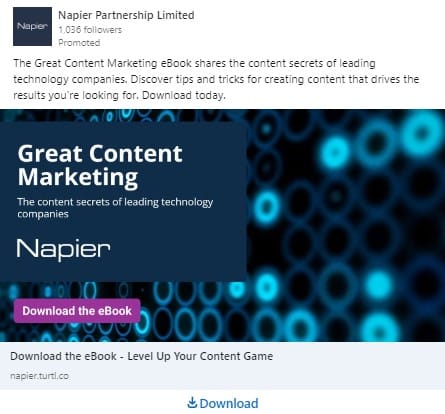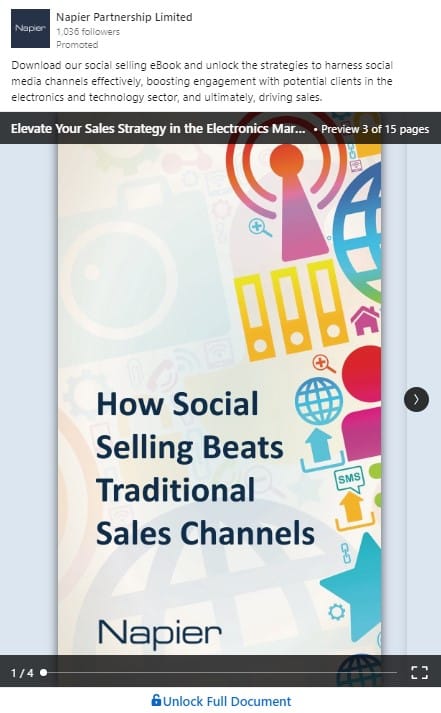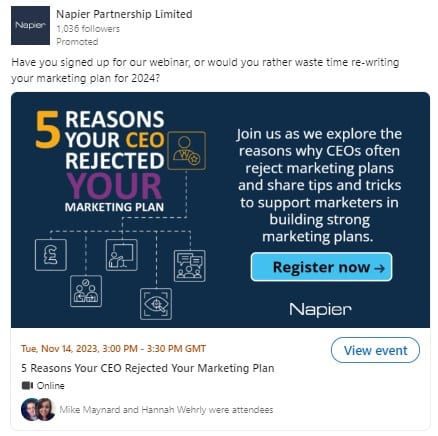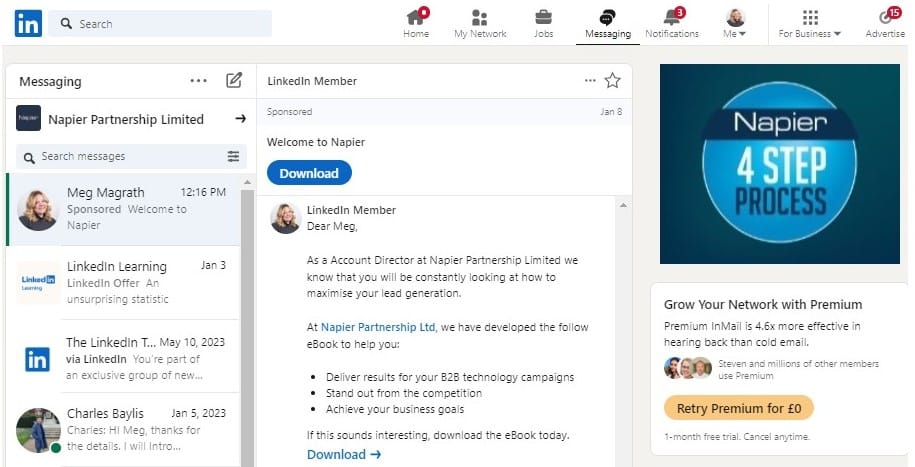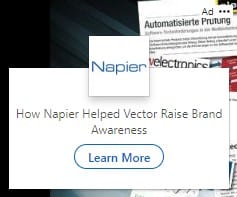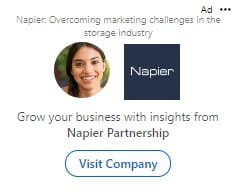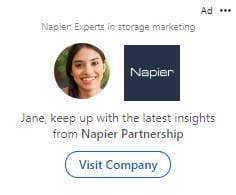LinkedIn advertising is a crucial part of the B2B marketing mix. With over 1 billion members in 200 countries worldwide using the professional networking platform, LinkedIn enables advertisers to utilise profile data to reach highly targeted audiences of influential decision-makers at scale.
A challenge when developing a paid LinkedIn campaign can be choosing the right format. This blog breaks down LinkedIn’s formats and how they align with B2B marketing strategies as well as sharing some tips along the way.
Sponsored Content
Single Image Ad – Promote messages directly in the LinkedIn feed using an image, introductory text and a headline.
The Single Image ad is relatively simple but can work across most strategies from brand awareness, to consideration, to conversion depending on the messaging deployed through both the imagery and text. The format includes optional CTA buttons to help drive audiences to take a desired action.
Top tips
- A/B test images, use different styles including photography of people, places and objects as well as testing graphics and illustrations to see what resonates best with the audience.
- Avoid using blues that blend with the LinkedIn palette – use colours that make the ad pop!
Carousel Image Ad – Tell a story using ‘cards’ that users can swipe through.
Carousel Ads can have 2-10 cards with their own headings and overarching introductory text. Cards can deliver sequential messaging telling a story, or alternatively, they can contain multiple messages, for example each card could feature a different product or service on offer. Delivering sequential or multi-messages means that Carousels work well in the consideration stage of the funnel; where an audience already have familiarity of a brand and will be receptive to more information.
Top tip
- Be cohesive and coherent – make sure your message is engaging for the audience. Don’t use Carousels to wedge in multiple messages unless it is valuable and appropriate to their customer journey.
Video Ad – Place video content directly in your audience’s feed, engaging with interactive content.
Video Ads are like Single Image Ads but use video rather than a static image. Videos can be 3 seconds – 30 minutes and must be in MP4 file format. Remember to always check specifications! Video Ads are best at the top of the funnel to build brand awareness using corporate videos that are short and snappy, however video content shouldn’t be completely disregarded further into the customer journey as it can be used to inform, educate, and engage users, pushing them further toward conversion.
Top tips
- Users have a short attention span; it’s crucial to grab their attention and deliver your message quickly. LinkedIn suggest videos under 15 seconds are the most successful.
- Whilst it’s true that short and snappy videos work well as ads, it’s worth considering using longer form videos with informative content that is highly relevant to your audience. With LinkedIn’s granular targeting helping you to reach the right people, using longer form video could be a good way to deliver relevant and informative content that audience strongly engage with. Of course, this goes against ‘best practice’ and should be tested with caution.
Document Ads – The introduction of Document Ads has been a game changer for B2B marketers. It gives you the opportunity to share long form content with audiences directly through their LinkedIn feeds.
With this format you can promote both gated and ungated documents. Ungated allows users to download and read content, boosting engagement; whereas gated assets will tease content and gain a user’s lead information in return for unlocking the full content – a true value exchange lead generation strategy. The ad format includes introductory text, headline and the document file. You can also choose how many preview pages to include in the ad.
Top tips
- Consider the relevance of your content – understand your audience well to pitch the content based on their existing knowledge. Don’t teach your audience how to suck eggs!
- Preview pages should entice the audience to want to read on, this increases the likelihood of them submitting a Lead Gen Form.
Thought Leader Ads – LinkedIn newest format, Thought Leader Ads, give advertisers the opportunity to boost their thought leader’s organic posts.
Thought Leader ads act as a brand awareness tool, building credibility and authenticity through a trusted voice. Position yourself as an industry authority to stand out from competitors and generate followers and engagement. No additional assets are required for this as the ad is simply sponsoring existing organic content. There isn’t an opportunity to utilise call-to-actions or lead generation with this format.
Top tip
- To measure impact, save the initial organic posts performance before launching a paid campaign.
Event Ads – Promote LinkedIn Live Events using just the LinkedIn Event URL and introductory text.
Event Ads can amplify attendance to live events hosted on LinkedIn. The image is dynamically pulled into the ad from the image used on the Event page. In terms of aligning to your strategy, events are great way to drive engagement and generate leads that can be nurtured through to conversion.
Sponsored Messaging
It is important to highlight that there has been a discontinuation of any Sponsored Messaging to countries in the European Union as of early 2022.
Message Ads – Send direct messages to drive engagement as well as generate leads.
Deliver targeted one-on-one messages to audiences with a single call-to-action. Message Ads include a CTA button, subject heading, body text and an image (desktop only). You can also include hyperlinks in the body text and add a Lead Gen Form. Message Ads can drive engagement, traffic to a landing page as well as generate leads due to the personalised approach.
Users only receive a message ad every 45 days to prevent fatigue and protect the member experience – so a small audience will struggle to deliver against the frequency cap.
Top tip
- Consider how your audience will benefit from this interaction, avoid an obvious sales approach. Utilise LinkedIn’s custom fields to create a personalised experience.
Conversation Ads – Reach your audience with a less intrusive experience and encourage them to click to engage and initiate conversations.
You can use multiple call-to-action buttons in Conversation Ads to give audiences the opportunity to access a range of content within one ad. Create personalised conversations that align with your objectives, for example LinkedIn recommend sharing customer success stories or showcasing products to raise brand awareness. Whereas for conversion and lead generation, LinkedIn recommend driving actions like event sign ups or content downloads.
Conversation Ads feature a headline, body text, footer and call-to-action buttons that contain a URL, Lead Gen Form or add another layer to the conversation. You select a sender, either a member or a company page. The change from pay-per-send to pay-per-click ensures that budget is spent on users who engage with the ad.
Top tip
- A sender should have a strong LinkedIn profile, be a relevant contact to your audience and have a public profile picture.
- Message and Conversation Ads sent from a member often outperform company senders, as users prefer a more personal experience that feels less like an ad.
Lead Gen Forms
Lead Gen Form are pre-filled with users profile data allowing audiences to submit their information in a few clicks. The form allows users to submit their details without leaving LinkedIn, reducing barriers to conversion.
Lead Gen Forms can be used across all Sponsored Content and Message formats (excluding Event and Thought Leader Ads) giving advertisers a range of opportunities to generate leads.
Top tip
- Whilst Lead Gen Forms have a long list of pros, it is important to consider the value exchange you are offering to the audience to maximise the lead generation potential of an ad.
- The ease of completing a form, when running to a broad audience, may result in quantity over quality compared to pushing an audience to visit a landing page to complete a form on your website.
Other formats
LinkedIn offer formats that feature in the right rail of the site (desktop only). These shouldn’t typically run in isolation and should be seen as supporting formats to a broader LinkedIn campaign.
Text Ads – Drive audiences to your landing page using a thumbnail, headline and short description.
This format previously drove strong, cost-effective results; however, LinkedIn redeveloped and removed the best performing ad position, making delivery of impressions nose-dive. LinkedIn encourages users to use Sponsored Content formats as an alternative, however, these have higher cost implications.
Top tip
- Use 2-3 ad variations to show variety to the audience as well as A/B testing the best strategy.
Dynamic – Spotlight Ads – Showcase products, services, events etc to help increase web traffic.
Spotlight Ads offer a personalised experience, featuring a user’s own LinkedIn profile data like their photo, job title, company name etc.
Dynamic – Follower Ads – Promote your LinkedIn Company Page and encourage the audience to follow.
Again, these ads offer the same personalisation as the Spotlight Ads mentioned above. Follower Ads support brand awareness and engagement with a company’s LinkedIn page.
Top tip
- Select ‘Engagement’ objective when setting up a campaign to run Sponsored Content campaigns with a ‘Follow’ button added to the ads. This encourages audiences to follow your page whilst featuring more content within the ad than standard Follower Ads.
To conclude, there are a wide range of opportunities to reach your target audience at every stage of their journey.
Success will come to those campaigns that utilise the correct targeting and appropriate content and formats to reach the right person, at the right time, with the right message.
At Napier we work with our clients, using our 4-step process, to determine who is the right audience and how to target them, we focus on developing the right message with the best format, we deliver a campaign utilising the best tactics, and we constantly optimise to enhance campaign performance.
We support clients to develop and repurpose content against proven strategies, as well as constantly testing and learning new approaches to achieve campaign objectives.

